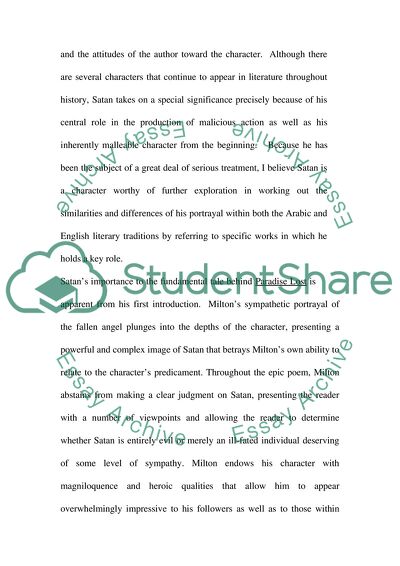
- Home
- Free Samples
- Premium Essays
- Editing Services
- Extra Tools
- Essay Writing Help
- About Us
- Studentshare
- Subjects
- Miscellaneous
- Satan in Paradise Lost
Satan in Paradise Lost - Essay Example

- Subject: Miscellaneous
- Type: Essay
- Level: Undergraduate
- Pages: 4 (1000 words)
- Downloads: 0
- Author: vgreen
Extract of sample "Satan in Paradise Lost"
In other forms of literature, Satan is depicted in a variety of different ways, similar to the way in which several other popular fictional characters take on different attributes as they progress through time and interpretation. There are many reasons these differences emerge, including religious or philosophical interpretations, social settings at the time the work is written as well as the social understanding of the time period in which the story is set and the attitudes of the author toward the character.
Although there are several characters that continue to appear in literature throughout history, Satan takes on a special significance precisely because of his central role in the production of malicious action as well as his inherently malleable character from the beginning. Because he has been the subject of a great deal of serious treatment, I believe Satan is a character worthy of further exploration in working out the similarities and differences of his portrayal within both the Arabic and English literary traditions by referring to specific works in which he holds a key role.
Satan’s importance to the fundamental tale behind Paradise Lost is apparent from his first introduction. Milton’s sympathetic portrayal of the fallen angel plunges into the depths of the character, presenting a powerful and complex image of Satan that betrays Milton’s own ability to relate to the character’s predicament. Throughout the epic poem, Milton abstains from making a clear judgment on Satan, presenting the reader with a number of viewpoints and allowing the reader to determine whether Satan is entirely evil or merely an ill-fated individual deserving of some level of sympathy.
Milton endows his character with magniloquence and heroic qualities that allow him to appear overwhelmingly impressive to his followers as well as to those within hearing of his voice. At the same time, Satan proves to have an impressive ability to corrupt those
...Download file to see next pages Read MoreCHECK THESE SAMPLES OF Satan in Paradise Lost
Where Are You Going, Where Have You Been by Joyce Carol Oates
Paradise Lost by John Milton
Character of Satan in the Book Paradise Lost
Comparing John Miltons Satan to Dantes Lucifer
Spawn: a Byronic Hero
Miltons Treatment of Satan in Paradise Lost
Inner conflict of Satan in Paradise Lost by John Milton
Where Are You Going Where Have You Been by Joyce Carol Oates

- TERMS & CONDITIONS
- PRIVACY POLICY
- COOKIES POLICY